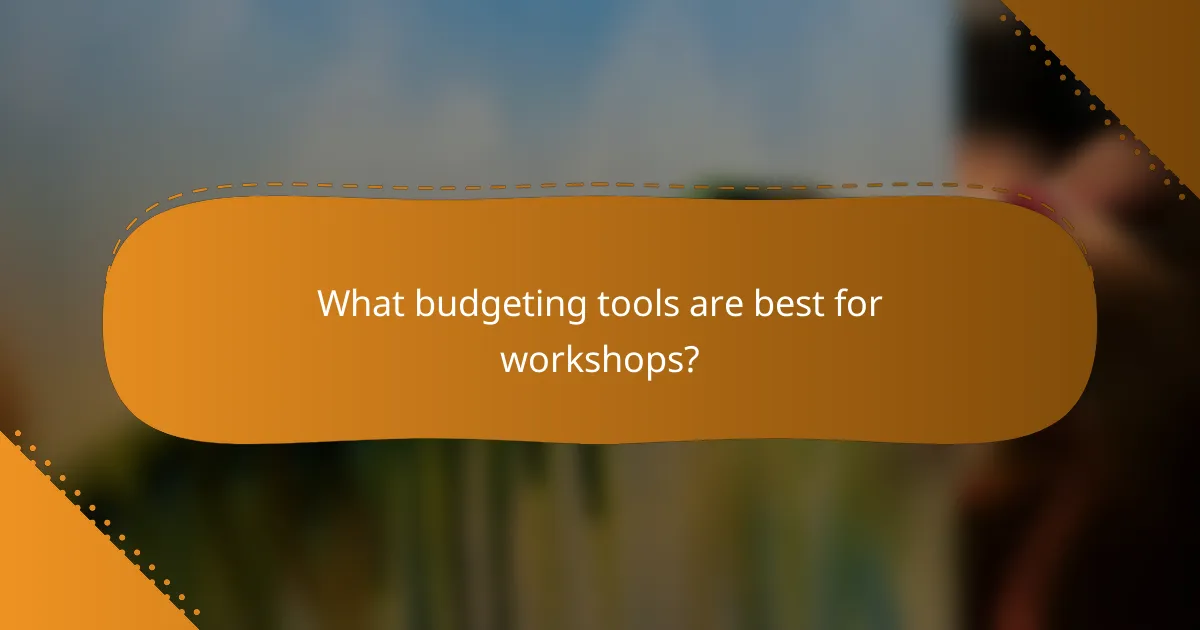Managing workshop finances requires a systematic approach to tracking expenses and budgeting. By categorizing all costs, from venue rentals to marketing, you can gain a clearer picture of your financial landscape. Utilizing effective budgeting tools can streamline this process, helping you allocate resources wisely and plan for future events.

How to track workshop expenses effectively?
To track workshop expenses effectively, establish a clear system that categorizes and records all costs associated with the event. This includes direct expenses like venue rental and materials, as well as indirect costs such as marketing and transportation.
Using Expensify for expense tracking
Expensify is a user-friendly tool designed to simplify expense tracking. Users can upload receipts, categorize expenses, and generate reports, making it ideal for workshop organizers who need to maintain accurate financial records.
To get started, create an account, link your bank or credit card, and begin logging expenses as they occur. Utilize the mobile app to snap photos of receipts for quick entry, ensuring you capture all relevant costs.
Implementing QuickBooks for budgeting
QuickBooks is a comprehensive accounting software that helps in budgeting for workshops. It allows users to create budgets based on historical data and projected costs, providing a clear financial roadmap.
To implement QuickBooks, set up a budget for your workshop by entering expected income and expenses. Regularly compare actual spending against your budget to identify areas where you may need to adjust spending or seek additional funding.
Utilizing Google Sheets for manual tracking
Google Sheets is a flexible option for those who prefer manual tracking of workshop expenses. It allows for customized templates and easy sharing among team members, making collaboration straightforward.
Create a spreadsheet with categories for different expense types, such as venue, catering, and materials. Regularly update the sheet with expenses as they occur, and use formulas to calculate totals and track budget adherence. This method is particularly useful for small workshops with limited budgets.

What budgeting tools are best for workshops?
Effective budgeting tools for workshops help track expenses, manage finances, and plan future events. Popular options include Mint, YNAB, and EveryDollar, each offering unique features tailored to different budgeting needs.
Mint for personal finance management
Mint is a comprehensive personal finance tool that allows users to track their spending, set budgets, and monitor financial goals. It automatically categorizes expenses, making it easier to see where workshop funds are allocated.
With Mint, you can create specific budgets for workshops and receive alerts when you approach your limits. This feature helps prevent overspending and ensures that all expenses are accounted for, which is crucial for effective workshop management.
YNAB (You Need A Budget) for proactive budgeting
YNAB is designed for proactive budgeting, encouraging users to assign every dollar a job. This approach is particularly beneficial for workshops, as it allows you to allocate funds to specific categories such as venue rental, materials, and marketing.
One of YNAB’s strengths is its focus on forward-thinking budgeting, which helps you plan for future workshops based on past expenses. Users often find that this method leads to better financial awareness and more controlled spending.
EveryDollar for simple budgeting
EveryDollar is a straightforward budgeting tool that emphasizes simplicity and ease of use. It allows users to create a monthly budget by dragging and dropping expenses into categories, making it ideal for those who prefer a no-frills approach.
For workshop budgeting, EveryDollar can help you quickly allocate funds to various expenses without the complexity of more advanced tools. This can be especially useful for small workshops or those new to managing event finances.

How to plan a workshop budget?
To plan a workshop budget effectively, start by identifying all potential expenses and income sources. A well-structured budget helps ensure that you allocate resources wisely and avoid overspending.
Creating a detailed budget template
A detailed budget template serves as the foundation for your financial planning. Include categories such as venue rental, materials, catering, marketing, and speaker fees. Using a spreadsheet can help you easily adjust figures and track expenses.
Consider using a template that allows for both fixed and variable costs. Fixed costs remain constant, while variable costs can fluctuate based on attendance or other factors. This distinction will help you manage your budget more effectively.
Estimating costs based on previous workshops
Reviewing costs from past workshops provides valuable insights for your current budget. Look at expenses like venue fees, catering costs, and materials to establish a baseline for your estimates. Adjust these figures based on changes in location, inflation, or expected attendance.
For example, if your last workshop cost around $2,000 and you expect a similar turnout, use that figure as a starting point. However, be prepared to modify it if you anticipate higher costs or a different venue.
Incorporating contingency funds
Including contingency funds in your budget is essential for managing unexpected expenses. A common practice is to set aside 10-15% of your total budget for unforeseen costs, such as last-minute venue changes or additional materials.
When planning, communicate the importance of this buffer to stakeholders. This transparency helps ensure everyone understands the need for flexibility in financial planning, reducing stress if adjustments are necessary later on.

What are the key criteria for selecting financial tools?
When selecting financial tools for tracking workshop expenses, budgeting, and planning, consider user-friendliness, integration capabilities, cost, and scalability. These criteria ensure that the tools will meet your specific needs and enhance your financial management processes.
Assessing user-friendliness of tools
User-friendliness is crucial for ensuring that all team members can effectively utilize the financial tools. Look for intuitive interfaces, clear navigation, and accessible support resources. Tools that offer tutorials or customer service can significantly reduce the learning curve.
Consider conducting a trial or demo of the financial tools to gauge their usability. A good rule of thumb is to choose tools that require minimal training time, ideally under a few hours, to get your team up to speed.
Evaluating integration capabilities with existing systems
Integration capabilities determine how well a financial tool can work with your current systems, such as accounting software or project management platforms. Ensure that the tool can seamlessly connect with your existing applications to streamline data flow and reduce manual entry.
Check for compatibility with popular software solutions used in your organization. Tools that offer APIs or built-in integrations can save time and enhance efficiency, allowing for smoother financial tracking and reporting.

How to analyze workshop financial performance?
To analyze workshop financial performance, focus on key metrics such as revenue, expenses, and return on investment (ROI). This involves collecting data from various sources and using financial tools to assess profitability and efficiency.
Using financial reports in QuickBooks
QuickBooks provides comprehensive financial reports that help track workshop expenses and income. Key reports include the Profit and Loss statement, which summarizes revenues and expenses, and the Balance Sheet, which offers a snapshot of assets and liabilities.
To effectively use these reports, regularly update your financial data and categorize transactions accurately. This ensures that your reports reflect the true financial status of your workshops, allowing for informed decision-making.
Tracking ROI with Google Analytics
Google Analytics can be a powerful tool for tracking the ROI of your workshops by measuring user engagement and conversion rates. Set up goals to track registrations or purchases directly linked to your workshop promotions.
To calculate ROI, compare the revenue generated from the workshop to the total costs incurred. A simple formula is: (Revenue – Costs) / Costs x 100. This will give you a percentage that indicates how effective your workshops are financially.

What are advanced budgeting techniques for workshops?
Advanced budgeting techniques for workshops involve strategic planning and resource allocation to ensure financial efficiency and effectiveness. These methods help workshop organizers manage expenses, forecast costs, and optimize funding sources.
Zero-Based Budgeting
Zero-based budgeting (ZBB) requires that every expense be justified for each new period, starting from a base of zero. This approach encourages a thorough review of all costs and can lead to more efficient spending by eliminating unnecessary expenses.
To implement ZBB, list all anticipated workshop costs, such as venue rental, materials, and marketing. Justify each item based on its necessity and potential return on investment. This method can be particularly useful for workshops with fluctuating attendance or variable costs.
Activity-Based Budgeting
Activity-based budgeting (ABB) focuses on the costs of specific activities required to run a workshop. This technique helps identify which activities consume the most resources and allows for better allocation of funds based on actual needs.
For example, if a workshop includes multiple sessions, analyze the costs associated with each session, such as speaker fees and materials. By understanding the cost drivers, you can prioritize funding for high-impact activities and potentially reduce spending on less critical ones.
Rolling Forecasts
Rolling forecasts involve continuously updating budget estimates based on actual performance and changing circumstances. This technique allows for more agile financial planning, adapting to unexpected changes in attendance or costs.
To utilize rolling forecasts, review your budget quarterly or monthly, adjusting projections based on recent data. This flexibility helps ensure that resources are allocated effectively throughout the workshop planning process, accommodating shifts in demand or expenses.
Scenario Planning
Scenario planning involves creating multiple budget scenarios based on different potential outcomes. This technique prepares workshop organizers for various financial situations, enabling proactive decision-making.
Develop best-case, worst-case, and moderate-case scenarios for your workshop budget. For instance, consider how changes in attendance or sponsorship might impact your financial outlook. By preparing for these scenarios, you can make informed choices and mitigate risks effectively.

